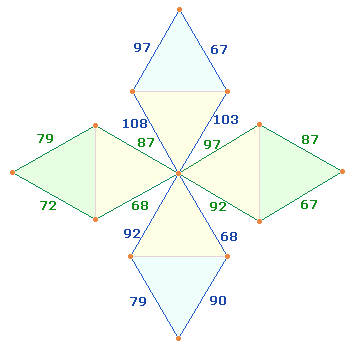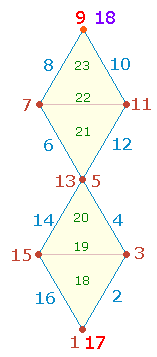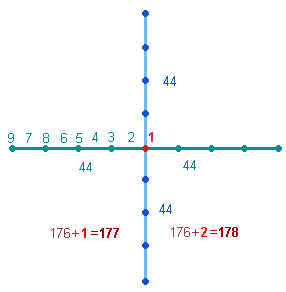Alphabets; gematric calculator
Shakespeare's
Epitaph
E. Gematric aspects of the 4 Y-Words;
G. Y-words in the Angel's Message to Mary
H. Ypsilon, Symbol for Jesus Christ
J. Jesus Christ's Titles in
Greek and Latin
Their
gematric connection with PENSATOR
I. Introduction
II. The Greek words
III. The Latin words
IV. The Greek and Latin words
K. Shakespeare
understands himself as Mary's Son
I. Introduction
1. The two previous
chapters G./H. of this study have shown that the
results achieved by the double count of the 4 Annunciation words HYIOS
HYPSISTOU, HYIOS THEOU perfectly fit the values of the name PENSATOR composed of the 8 different letters of
the
If
meaningful relations, ratios and proportions can be found, then this is not the
result of human ingenuity, but wrought by God's providential plans. The
2. Proportion of values of
the 4 Annunciation words and PENSATOR was reached by the following
procedure: The numerical sum 102 of PENSATOR was assigned to the
23-count of the numerical sum (NS) 354 + factoral sum (FS) 248 , The FS 80 to the 22-count of the NS 351 and FS 218. The results are both
divisible by 11: 704 = 11*64, 649
= 11*59. The total sum is 1353.
The four
Annunciation words consist of 24 letters, e.g. 3 letters to 1 of PENSATOR. By establishing 8 separate results, more
differentiated interrelations may be found.
3. The corresponding Latin
titles FILIUS ALTISSIMI, FILIUS DEI consist of 24 letters as well. Their combined values 270+177 + 1353 add up to 1800. So a further
caclulation has to be carried through.
4. At this stage of the
investigation it does make real sense to speculate how much of these
mathematical relations was known to Shakespeare himself. But it is useful to
imagine that he was capable of the most sophisticated thinking and mathematical
calculations.
5. It may not be to
everybody's taste to go through the following lists of numbers. On the other
hand, why should the science of divine order be less complex than any worldly
science like medicine, biology or astronomy? Against God's infinite wisdom the
capacity of human comprehension is very limited. Nevertheless, the little that
man's intelligence is able to discover can fill his mind with wonder and
admiration.
II. The Greek words
1. To each letter of PENSATOR three letters of the
four Greek words are assigned in the order of their occurrence. The numeric
values (NV) of PENSATOR go to the blue numbers (23-count of Y), the factoral values (FV) to the green numbers (22-count of Y):
|
P |
E |
N |
S |
A |
T |
O |
R |
||||||||
|
H |
O |
Y |
I |
O |
Y |
S |
E |
||||||||
|
Y |
S |
P |
S |
Y |
I |
T |
O |
||||||||
|
I |
H |
S |
T |
H |
O |
H |
U |
||||||||
|
90 |
72 |
68 |
68 |
108 |
97 |
97 |
87 |
67 |
67 |
103 |
92 |
92 |
87 |
79 |
79 |
|
162 |
136 |
205 |
184 |
134 |
195 |
179 |
158 |
||||||||
|
638:715
= 11*(58:65) |
|||||||||||||||
The totals of numbers
which form a frame of each half and the correspondent central numbers are
divisible by 11. The sense of this arrangement becomes clear if the numbers are
assigned to the lines of two double rhombi (DR) in the shape of an
eight:
|
|
2. A cross of 2 DR can be
folded to form an octahedron. That this is the intention of these
numbers, is confirmed by the following balance calculation:
|
|
|
|
sm |
FV |
|
NS |
638 |
715 |
1253 |
55 |
|
FV |
42 |
29 |
71 |
71 |
|
sm |
|
|
|
126 |
Here the
number 126 has to be understood as 1+26. One refers to the element
of the volume and 26 to the number of the octaeder's outside elements: 6 corners, 8 areas, 12 lines.
III. The Latin words
1. The Latin titles FILIUS
ALTISSIMI,
FILIUS
DEI have
the following values:
|
|
NV |
FV |
sm |
|
NV |
FV |
sm |
NS |
FS |
sm |
|
FILIUS |
73 |
45 |
118 |
FILIUS |
73 |
45 |
118 |
146 |
90 |
|
|
ALTISSIMI |
106 |
72 |
178 |
DEI |
18 |
15 |
33 |
124 |
87 |
|
|
sm |
179 |
117 |
296 |
|
91 |
60 |
251 |
270 |
177 |
447 |
2. The NS 270 corresponds, in the
product form 15*18, to the FV and NV of DEI. As plural of DEUS the three-letter word
may intimate the three divine persons. Geometrical model of the two numbers is
the frame of the double rhombus consisting of 4+4 lines – the basic model of PENS|ATOR – inclosed by 7 points. If the frame is numbered in the form of an 8, and folded for the
construction of an octahedron, the 15 elements are increased
to 18:
|
|
The
combined result of NS+FS 447 point to this
assumption about the meaning of 270. Perhaps it should be mentioned
that the NS+FS of CHRISTUS is 188 = 4*47.
The FS 177 refers, beside the
frame of the double rhombus, to a cross of axes whose arms consist of 9 elements numbered from
the centre to the margin:
|
|
3. According to the above
pattern the 24 letters are assigned to the 8 letters of PENSATOR:
|
1 |
2 |
3 |
4 |
5 |
6 |
7 |
8 |
||||||||
|
F |
I |
A |
I |
I |
F |
I |
D |
||||||||
|
I |
U |
L |
S |
M |
I |
U |
E |
||||||||
|
L |
S |
T |
S |
I |
L |
S |
I |
||||||||
|
26 |
22 |
47 |
23 |
31 |
31 |
45 |
22 |
30 |
19 |
26 |
22 |
47 |
23 |
18 |
15 |
|
48 |
80 |
62 |
67 |
49 |
48 |
70 |
33 |
||||||||
|
P |
E |
N |
S |
A |
T |
O |
R |
||||||||
|
15 |
8 |
5 |
5 |
13 |
13 |
18 |
8 |
1 |
1 |
19 |
19 |
14 |
9 |
17 |
17 |
|
41 |
30 |
52 |
28 |
44 |
44 |
63 |
30 |
31 |
20 |
45 |
41 |
61 |
32 |
35 |
32 |
|
71 |
80 |
88 |
93 |
51 |
86 |
93 |
67 |
||||||||
|
71 |
13 |
17 |
34 |
20 |
45 |
34 |
67 |
||||||||
By adding
the factoral sums, the NS 6*17 of PENSATOR is increased by 31*17 so that the total NS+FS is 629 = 37*17.
4. At first sight there
are no symmetrical proportions. The 4 numbers marked with green background and
the 4 other numbers have the ratio 323:306 = 17*(
However,
if the positions and FV and the positions of letters (adding up to 36) are added, symmetry
becomes visible: 629+36 = 665 = 35*19.The sum of the first
half is 332, the added positions 10, the result is a ratio of the first to the second
half of 342:323 = 19*(
The factoral values of
the 8 NS+FS amount to 301. The following table
shows the symmetric pattern:
|
71 |
80 |
88 |
93 |
51 |
86 |
93 |
67 |
629 |
|
71 |
13 |
17 |
34 |
20 |
45 |
34 |
67 |
301 |
|
235 |
434 |
261 |
930 |
|||||
|
496:434 = 62*(8:7) |
||||||||
If the
sum of positions 36 is added, the result 966 is divisible by 23, for which two sums of
4+4 can be found:
|
1 |
2 |
3 |
4 |
5 |
6 |
7 |
8 |
36 |
|
71 |
80 |
88 |
93 |
51 |
86 |
93 |
67 |
629 |
|
71 |
13 |
17 |
34 |
20 |
45 |
34 |
67 |
301 |
|
346 |
207 |
137 |
276 |
966 |
||||
The ratio
of the numbers 207:276 is 69*(3*4). The two groups of numbers amount
both to 483 = 21*23.
The
positions of the two groups of numbers can be put together to 4-digit numbers:
|
|
factors |
FV |
|
4578 |
6*7*109 |
121 |
|
1236 |
12*103 |
110 |
|
121:110=11*( |
231 |
|
231 is the sum of the numbers 1-21.
IV. The Greek and Latin words
1. Now all the numerical
and factoral values of the 22- and 23-count of the Greek words, the values of the Latin
words and PENSATOR are added according to the 8 letters dealt with so
far:
|
1 |
2 |
3 |
4 |
5 |
6 |
7 |
8 |
36 |
|
210 |
206 |
267 |
251 |
183 |
243 |
249 |
191 |
1800 |
|
909:891
= 9*(101:99) |
||||||||
The total
NS+FS is 1077+723. The first number refers
to the frame of the double rhombus, the second to the 7 elements of a
triangular side of the tetraktys and to 5 diametrical elements
of the basic circle.
2. The only 4:4 ratio can be achieved
if the numbers of the uneven (1-3-5-7) and even (2-4-6-8) positions are added.
Hoever, a symmetrical ratio exists among the numbers of the uneven positions (P):
|
P |
|
P |
|
|
1 |
210 |
3 |
267 |
|
7 |
249 |
5 |
183 |
|
|
459 |
|
450 |
|
9*(51:50) |
|||
With the total result 1800, one might expect a
higher common factor than 9. But if Jesus Christ's greatest merit for the
salvation of mankind was his death on the cross, its 9 elements are
essential. Because of the symmetrical conditions found among the uneven
positions, the 4+4 numbers have to be placed on the two axes of the cross,
first from top to bottom and then from left to right. As the numbers are placed
on the lines, the number of elements has to be expanded to 17:
|
|
Among the
even numbers only 243 is divisible by 9 and forms an inverted ratio
against the other 3 numbers: 243:648 = 9*(27:72).
The FV of the two pairs of
numbers are divisible by 9:
|
NV |
FV |
NV |
FV |
|
459 |
26 |
243 |
15 |
|
450 |
18 |
648 |
18 |
|
|
44 |
|
33 |
3. The ratio 9*(101:9*11) = 9*101:9*9*11 confirms the shape of
the above cross: Each axis consists of 9, together 18 elements. Three times 9 symbolises Christ's
trinitarian origin. 101 and 11 both represent the second divine person and his role
of completing the creation (cf. previous chapter), the
added result 112 is the numeric value of CHRISTUS. The NS+FS of the numbers 1-10 are 55+46 = 101.
The trinitarian origin
of the decimal system can be seen from the NS 270 of the 4 Latin words. It takes
up 3 parts out of 20 of the total NS+FS 1800. The ratio is 90*(
|
|
NV |
FV |
|
1-9 |
45 |
39 |
|
1-10 |
55 |
46 |
|
|
100 |
85 |
The
internal ratio 85:100 is 5*(17:3). The two ratio numbers
have to be understood as composed of 9+8 and 1+2 and so as symmetric complements on the scale of
the basic numbers 1-9.
Written: February 2009



